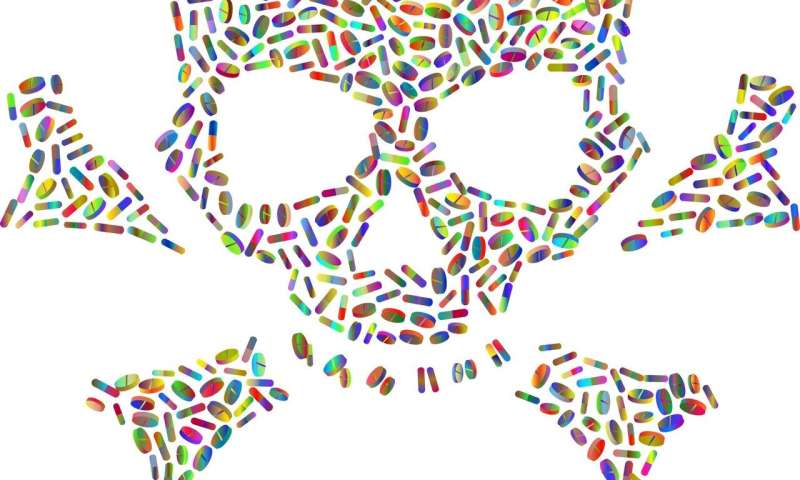Opioid solutions found beyond the headlines

Every day, the headlines offer yet another example of how the ongoing opioid epidemic is devastating communities and individual lives. But given the significant role popular media plays in shaping public perceptions, where is this non-stop coverage taking us?
One Western researcher feels the conversation has taken a wrong turn and, if we are to tackle the challenges associated with opioids, then we may need to step back from the headlines and look at the bigger picture.
"We started out as saying 'opioids are safe,' to occasionally 'patients running into problems from unknowing or naive physicians misguided by big pharma,'" Nursing professor Fiona Webster explained. "Then we shifted into talking about innocent patients as criminals and addicts. Then a shift focusing on illicit drug use."
"Even calling this an 'opioid epidemic' is locating the problem in a class of drugs. We're never truly looking as systemic institutionalized issues, especially around social equity."
Previously, Webster conducted numerous qualitative studies around physician experiences in managing patients with chronic pain. Now, she has expanded her work to determine the role national media plays in directing the narrative around the opioid epidemic.
Webster's most recent study, A critical content analysis of media reporting on opioids: The social construction of an epidemic, was published in the scholarly journal Social Science & Medicine.
Her team looked at more than 800 articles from three news outlets (CBC News, The Globe and Mail and The National Post) from 2000-17 to discover where the headlines were drawing attention and, conversely, from where it was distracted around the issue of opioids.
Many of the news articles used dramatic and sensational language to describe opioid use in Canada, including references to "crisis," a "hidden killer" and a "skyrocketing" problem, she said. There was a lot of overlap between defining the scope of the problem and efforts to identify which individuals and groups were to blame for the problems arising from opioid use.
"The problem was rarely pharma, but was increasingly the individual addict. They are lumping everybody in as one and overlooking social context that they'll be more issues around mental health and addition," Webster said. "Drug use isn't looked at in the context of understanding mental health or poverty. If the problem is illicit drug use and criminality then police become the solutions."
Roughly 10 percent of all articles identified unsafe prescribing as the root of the problem, thereby implicating physicians as a blameworthy cohort. Similarly, discussions of the legal and political context were bound up with blaming governing bodies, such as provincial and federal governments.
A secondary theme involved criminality. Within that, there were a number of different avenues explored, including drug trafficking; behaviour of addicts, for instance, seeking fentanyl on the street; the crushability of prescription opioids; even unscrupulous physicians and pharmacists who knowingly profit from the illegal trade in prescription opioids.
"Patients tend to be dichotomized as either innocently following physician prescriptions or drug-seeking, as an aspect of lives characterized by addiction and street crime," Webster said. "These depictions map onto characterizations of physicians as naively following pharmaceutical industry advice or becoming irrelevant once criminality is introduced."
Webster is not blaming the media for this ongoing narrative; they are "a mirror to understand people's values and norms" being reflected in the stories. The social construction of the opioid epidemic polarizes individuals as 'good' or 'bad," with little attention paid to underlying institutional interests in the creation of the problem or in the solutions proposed.
"We are more interested in stigmatizing certain groups than we are looking at the problems holistically," she said. "We see a huge amount of stigmatization in those who are poor or with mental health and addiction issues. They become criminalized. Blaming and stigmatizing those who suffer with chronic pain becomes a higher priority than implementing safer and effective therapies for managing their pain."
In critiquing media narratives, Webster is not suggesting anxieties about opioids are unfounded. The problems of addiction and overdose are significant and real, and proposed solutions such as improved access to antidotes and addiction treatments are urgently needed.
However, with this narrative shift away from stories about naive physicians and so-called innocent patients towards an increasing focus on street-use and criminalization references to broader social circumstances, such as social inequity and racism, disappear from view.
"It takes our attention away from harm reductions. We're beginning to see more the sense of hopelessness around the issue; it's so out of control there's nothing we can do," said Webster, adding the way people think about the opioid epidemic raises these stereotypical ideas as to who's at fault.
"It's a way for people to distance themselves. It's not in my backyard; it those addicts out on the street," she continued. "We need to do things at the systemic level rather than focusing on these individual bad patients and the occasional individual bad physician. We need to focus on the social context for all these issues. We need to understand things at the institutional level so we can begin to understand and really focus on health and social equity."
More information: Fiona Webster et al. A critical content analysis of media reporting on opioids: The social construction of an epidemic, Social Science & Medicine (2019). DOI: 10.1016/j.socscimed.2019.112642
Journal information: Social Science & Medicine
Provided by University of Western Ontario




















